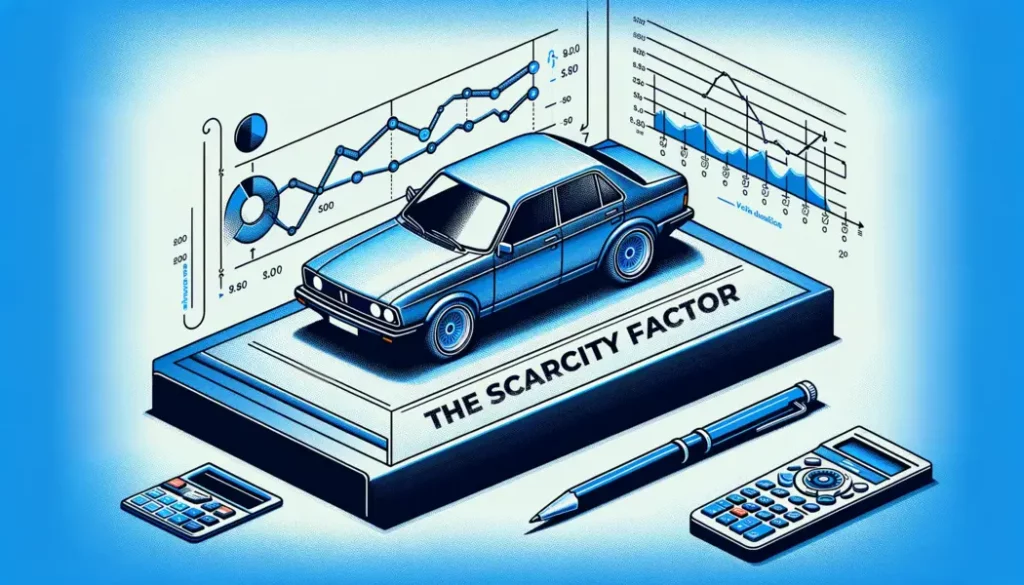Abstract
In response to the limitations of traditional vehicle valuation methods, Appraisal Engine Inc., under the guidance of Tony Rached, has developed the Scarcity Factor (SF), a sophisticated model designed to dynamically adjust vehicle prices based on market scarcity.
This innovation, which is currently under a patent-pending application, is the culmination of an extensive analysis of thousands of vehicle listings and hundreds of cash value appraisal reports, offering a groundbreaking approach to accurately reflecting a vehicle’s current market value.

Introducing the Scarcity Factor: A New Era in Vehicle Valuation (PDF)
Introduction
The automotive resale market is characterized by its dynamic nature, with vehicle values fluctuating in response to a variety of market conditions. Traditional valuation models, relying on historical depreciation data, often fail to capture the real-time state of the market.
Recognizing this gap, Appraisal Engine Inc. introduces the Scarcity Factor (SF), a novel methodology conceptualized by Tony Rached to provide a more accurate, market-responsive valuation of used vehicles.
USPTO Patent Application Brief: System and Method for Adjusting Vehicle Value Based on Scarcity Factor (PDF)
Methodology
The development of the SF model involved a rigorous analytical process, reviewing thousands of vehicle listings and analyzing hundreds of cash value appraisal reports. This comprehensive data collection effort enabled the identification of key factors influencing vehicle scarcity and, by extension, market value.
The proprietary algorithm of the SF model considers variables such as the availability of comparable vehicles within a defined radius, their prices, mileage, and condition, to compute the Scarcity Factor, which then informs the adjusted market value of the vehicle.
Results
The implementation of the SF model revealed a strong correlation between the calculated Scarcity Factor and the market value adjustments of vehicles. Notably, vehicles exhibiting higher SF values, indicating relative scarcity in the market, commanded premium prices.
Conversely, vehicles with lower SF values, reflecting greater availability, were adjusted to lower market values. These findings validate the effectiveness of the SF model in aligning vehicle prices with current market dynamics.
Discussion
The introduction of the Scarcity Factor by Appraisal Engine Inc. signifies a significant leap forward in the field of vehicle valuation. This patent-pending model transcends the limitations of traditional valuation methods by incorporating a dynamic, real-time analysis of market scarcity.
The SF model not only enhances the accuracy of vehicle valuations for buyers and sellers but also provides invaluable insights into the broader trends affecting the automotive resale market.
Conclusion
The Scarcity Factor, developed by Appraisal Engine Inc. and conceptualized by Tony Rached, represents an innovative approach to vehicle valuation, addressing the critical need for a more responsive and accurate valuation tool in the automotive market.
As the industry continues to evolve, the SF model, supported by its patent-pending status, is poised to become a pivotal tool in the valuation of used vehicles, reflecting Appraisal Engine Inc.’s commitment to innovation and market leadership.
Acknowledgments
The development and refinement of the Scarcity Factor model were made possible through the dedicated efforts of the team at Appraisal Engine Inc., alongside the invaluable contributions of automotive experts, data scientists, and the many participants who provided access to listings and appraisal reports.
References
This overview is based on the proprietary research and development activities conducted by Appraisal Engine Inc., including the analysis of thousands of vehicle listings and hundreds of cash value appraisal reports.
Detailed methodologies and the results of this comprehensive analysis are documented internally, contributing to the foundation of the patent-pending Scarcity Factor model.



